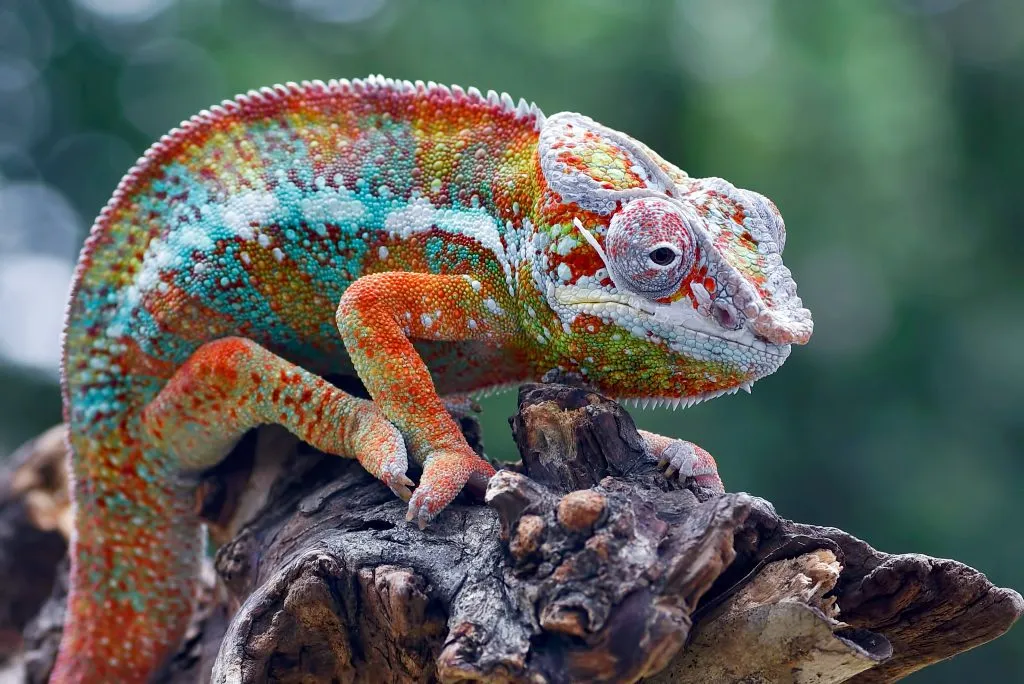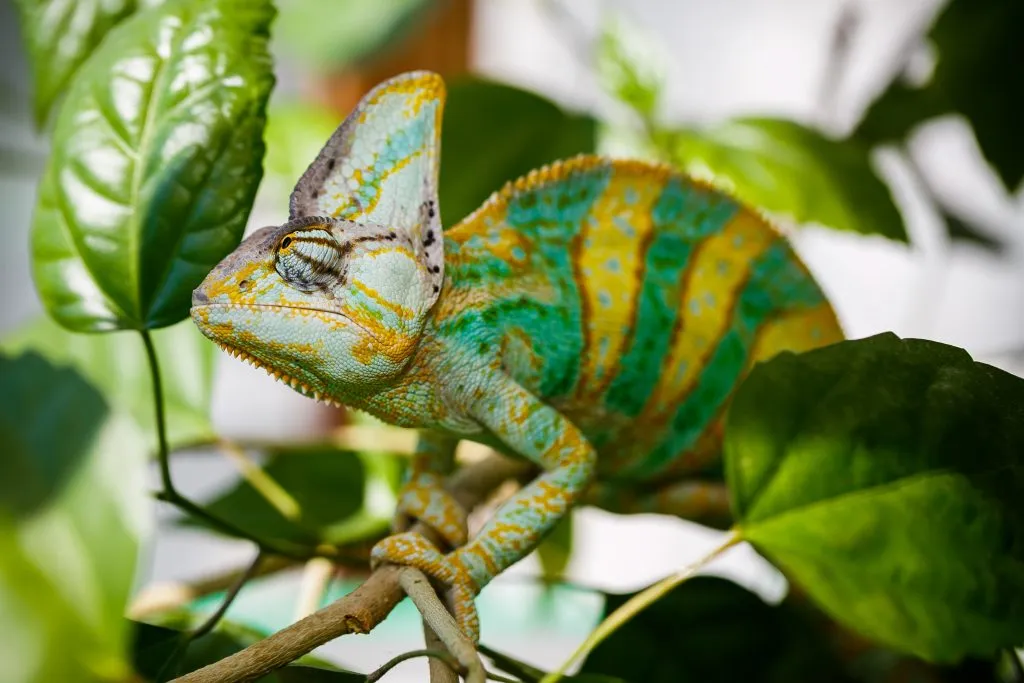
We all know that chameleons can take on a wide array of hues and patterns, but have you ever noticed white spots on your chameleon that didn’t use to be there?
White spots on a chameleon can mean many things. Maybe it’s part of its natural color pattern. It could be from shedding, an injury, or a burn. If it’s around the nose, it could be snalt. But sometimes, it’s a symptom of a bigger problem, like viral, bacterial, or even fungal infections.
In this article, we’ll look at the possible causes of white spots on a chameleon and what to do if you see them.
Table of Contents
10 Causes of White Spots on a Chameleon
Here are ten possible causes of white spots on a chameleon, ranging from “not a concern” to “concerning.”
1. Color Pattern

Sometimes, there’s really no reason at all for the white spots. Some chameleons naturally have intense color patterns, and white spots may be a part of that. This is just the way they’re born, and there’s nothing to worry about.
2. Thermal Burn
If you notice white spots in an area where your pet can get near a hot surface, such as his casque or his back, then it’s could be a thermal burn.
Thermal burns are caused by either direct contact with or too much time near a hot surface. In the case of pet chameleons, this usually happens when they get too comfortable staying next to their heat source.
Unlike humans, reptiles like chams can’t quickly move away from extreme heat.
One theory is that their bodies didn’t evolve to develop the nerve receptors–and therefore the reflexes–needed to react to such types of temperature changes because they didn’t encounter extremely hot things in the wild.
To say it simply, their bodies don’t have the capacity to register the sensation fast enough for them to move away.
This is especially worrisome in the winter when the temperature in their environment drops. It’s the time when most pet chameleons get thermal burns because they want to move as close to their heat source as possible.
To prevent this from happening, avoid making the following mistakes:
- Placing the heat lamp or perches too close to the top
- Letting the lamp or bulb touch the top of the enclosure
- Using too many bulbs or too high wattages
Additionally, it’s important to check your chameleon’s light for any cracks or holes. Not only could it let heat escape and possibly burn him, but it could also put him at risk of electrical shock.

Thermal burns will appear white when they’re in their blister phase, but once the wound starts healing, it tends to darken to black or gray.
The burn scar won’t go away on its own, but since chameleons shed, you should see some improvement after a couple of cycles.
3. Injuries
If your chameleon has sustained any kind of trauma, such as being attacked by another animal or getting caught in a branch, it’s possible that some of the cells in its skin were damaged.
As a result, some parts of the skin may appear white or pale against your chameleon’s normal coloration before darkening as they heal.
Of course, if your chameleon displays any signs of distress or changes in behavior like lethargy, it’s recommended that you take them to a vet for further examination.
Although white spots from injuries should typically heal over time, seeking professional advice may be the best course of option in this case.
4. Water Spots
If you’re using tap water when misting your enclosure or adding calcium supplements to their
Many calcium supplements typically come in the form of a powder, which then has to be mixed with water. Meanwhile, tap water may sometimes be hard water, which is known to leave stains.
When either one of these options drips onto your chameleon’s skin, they can form white spots – essentially water spots or water stains.
If this is the case, you should also see white splotches on other parts of your enclosure, such as the leaves and decor.
5. Snalt
White spots around a chameleon’s nostrils are colloquially known as snalt.
Unlike mammals, reptiles don’t sweat or urinate, which is how we eliminate salt buildup in our bodies. Instead, they have special glands around their noses that help expel it from their system.
Obviously, chameleons aren’t able to pick off the white, crusty residue that forms on their noses from concentrated sodium, so it can accumulate over time – especially if you have an enclosure that’s not humid enough.
Luckily, snalt in chameleons is rather easy to deal with. All you have to do is to increase the humidity inside the enclosure, and the white spots should pretty much evaporate off of your cham’s face.
6. About to Start Shedding
White spots could also be an indication of shedding. Reptiles like chameleons often shed their skin in order to remove the old, dead cells from their body and make way for new ones.
When they’re getting ready to shed, their color may start fading and white spots may start to appear. These spots are actually dead skin that’s starting to lift off of their body.
They may even start rubbing against the plants and decor to loosen up the dead skin.
The best thing you can do during this time is to support them with extra hydration inside the enclosure, making it easier for the dead, loose skin to fall off.
You can also increase your misting frequency to maintain the air’s humidity.
7. Stuck Shed

Every now and then, chameleons may have a hard time shedding off their dead skin. These patches of loose skin will be stuck on their body, giving the appearance of white spots.
We know you’re probably tempted to pick these off, but don’t.
The fact that your cham failed to shed those pieces of dead skin is proof that they’re probably still connected to its new skin somehow, which means it will hurt if you pull them off.
What you can do instead is to give your chameleon a little gentle misting, especially on the white patches. Some even give their cham a “hydrating mask” made of wet paper towels to help soften the dead skin.
As long as you’re careful and gentle, this should eventually loosen up the old skin until it falls off on its own. You can also try to remove the patches yourself by wiping them over with a wet cotton ball or cotton swab.
If they still won’t come off after this attempt, just leave them for now and try again later.
Keep in mind that if your cham is frequently dealing with stuck sheds, even when it’s properly hydrated and the enclosure has the right humidity levels, it could be a sign of some deficiency in its diet or even a fungal infection.
You may want to take a closer look at what you’re feeding your chameleon and adjust if necessary.
If that’s not it, you should probably look out for other symptoms of a fungal infection, as they can also cause stuck sheds.
8. Bacterial Infections
Chameleons can also get white spots from bacterial infections. They can be caused by the chameleon coming in contact with something contaminated, or simply just being in an unsanitary enclosure.
They usually start off as small white dots, but they could spread if left untreated.
In the photo above, the white spot on the chameleon’s knee has a smaller dark spot in the middle of it – this is pus that has formed beneath the skin.
If you suspect your cham is suffering from a bacterial infection of some kind, the safest option is to take them to a vet for proper diagnosis and treatment.
Depending on the severity of the infection, your vet may prescribe a course of antibiotics to get rid of the bacteria causing the discoloration.
9. Fungal Infections
Fungal infections are a common problem in reptiles.
Some of them can also cause white spots or yellow spots on a chameleon. Unlike bacterial infections that seem to form spots specifically, though, many fungal infections will look a lot more spread out.

For example, Nannizziopsis draconii is the fungi family responsible for most of the fungal dermatitis cases in reptiles, and it can cause white-looking patches.
This is actually due to lesions that are essentially ‘eating’ the skin, and the condition can be fatal if left untreated.
Symptoms of fungal infections include:
- Discolored spots (white, yellow, or black)
- Unusual growths on the skin
- Extremely dry skin
- Shedding problems (Excessive shedding, not shedding at all, or constantly stuck shed)
If you suspect that your chameleon has a fungal infection, it’s best to take them to a herp vet for proper assessment and treatment.
Remember, these fungi grow in the environment, so if you want to prevent them from making it to your chameleon, you need to make sure that your cham’s enclosure is well-maintained.
Additionally, cuts in the skin and stress can heighten the risk of fungal infections, so be sure to address any health issues that your cham is having.
10. Viral Infections
If the white spots on your chameleon are raised or seem wart-like, it may be suffering from a viral infection, particularly papillomavirus.
Papilloma is an extremely contagious virus in lizards. It’s transmitted through direct contact with another infected animal, or even contact with something that the infected animal has touched.
Sadly, owners who have warts on their hands can also infect their chameleon with the virus.
Symptoms of papillomavirus include:
- Discolored spots/lesions on the skin and/or mouth
- Raised bumps on the face, legs, or tail
- Abscesses in the eyes, nose, or mouth
Since papilloma is quite serious, we recommend taking your chameleon to the vet as soon as possible upon seeing these symptoms.
Make sure you don’t touch your chameleon with bare hands, as the virus can transfer to humans as well.
Unfortunately, there is no known cure for papillomavirus yet. That said, your vet can recommend ways to manage the disease and help keep your cham comfortable.
For example, if the warts are in an inconvenient spot, your vet may recommend cauterizing them, similar to how it’s done with humans.
They may also perform surgery on large warts. These can still regrow, but this process can help reduce their size and appearance.
The good news is that you can still give your chameleon a happy life despite the papillomavirus.
You will have to take precautions, such as never touching your cham with bare hands, never letting them near another animal, and always cleaning everything they touch outside of their enclosure, but it’s still possible.
FAQs

Can too much calcium cause white spots around my chameleon’s nose?
White spots around your chameleon’s nose are usually just snalt, which is made of concentrated sodium, not calcium.
It’s a common misconception that too much calcium causes snalt – many owners who give calcium supplements who see the snalt immediately think of calcium because it’s also a white, powdery material.
Can white spots in chameleons be caused by nutrient deficiencies?
Nutrient deficiencies don’t cause white spots in chameleons, but they do need an abundance of vitamins and minerals to stay vibrant. Normally in the wild, they can get these essential nutrients from eating different types of
However, when kept as pets, their access is obviously limited to what is provided to them. You can give them supplements or gutload your feeders with all the necessary nutrients to make sure they’re not missing any important ones.
- Enchi Ball Python: A Unique and Stunning Morph of Python regius - March 27, 2025
- Emerald Tree Monitor: The Enigmatic Green Guardian of the Rainforest - March 26, 2025
- The Egyptian Cobra (Naja haje): A Fascinating Serpent - March 25, 2025
